Silver Sebright bantams are a livestock heritage breed of true bantam that was developed about 200 years ago in Britain by Sir John Sebright. Silver Sebrights are black in color with white lacing and are considered an ornamental breed, generally kept for competing at Poultry Shows rather than for egg and/or meat production. Aside from silver, Sebrights can also come in a golden variety, and as true bantams, they do not have standard size chicken counterparts.
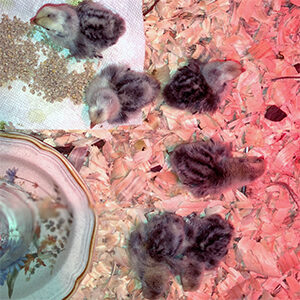
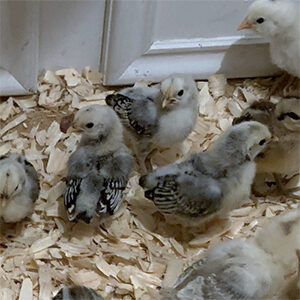
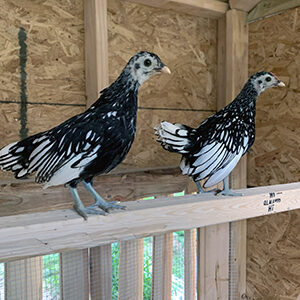
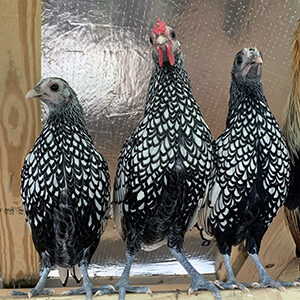
Hens grow to about 1.25 pounds, and roosters should weigh about 1.5 pounds maximum. Sebrights are talkative, social, flighty, and generally non-aggressive. Sebrights have four toes with unfeathered, slate blue legs and skin, dark blue or horn color beak, black or dark eyes, and the Silver variety should have white feathers with black lacing that evenly outlines the white on each feather. Sebright roosters feature a rose comb but feather like the hens and unlike most roosters, they do not feature the sickle shaped feathers in the tail, neck, and saddle, which is the area above the tail feathers but below the upper back/neck. Sebrights are great flyers and need to be kept in a closed coop or run. Even with great flying capabilities, these birds generally prefer to roost 0-2 feet off the ground. Sebrights can become quite docile when handled daily, which is good chicken care anyway to check for mites and overall health of the flock. Sebrights have a life expectancy of up to eight years.
Sebright hens start laying eggs around 18 weeks old and lay about 70 eggs per year. The eggs are a light cream color and bantam size, which are often rated USDA PeeWee, at under 15 ounces per dozen eggs. Sebright bantams are generally considered an ornamental breed as they are not a reliable source of eggs or meat and typically live 4 to 5 years old. Sebrights rarely go broody and aren’t the best mothers, so breeders often rely on incubators and surrogates. Unlike most other breeds, Sebright cocks do not grow sickle feathers in their tail, saddle, or neck; instead the roosters share feathering patterns with the hens and commonly have low fertility. To increase their success to breed, cocks need warmth, so the best mating time is usually April through June.
APA/ABA Class: Rose Comb Clean Leg (RCCL)
American Poultry Association
American Bantam Association
Livestock Conservation Status: threatened
The Livestock Conservancy
Black Silkie bantams are an ornamental bantam breed that originated in Asia and are known for their excess plumage and feathery feet and is amongst the most recognized bantam and backyard breed. Along with their adorable fluffiness, silkie bantams, sometimes spelled silky, are known for having dark bluish black color skin and bones and have five toes, instead of four, which is more typical in chickens. Silkies, sometimes called the Chinese Silk Chicken, are available in bearded and non-bearded varieties, bantam or standard size, and appear in blue, black, white, partridge, buff, gray, and splash, along with many colors not currently accepted by breed standards.
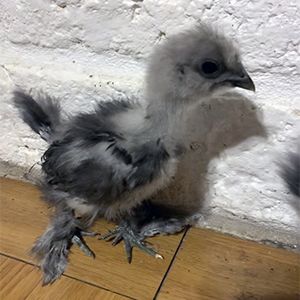
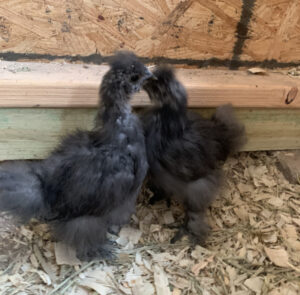
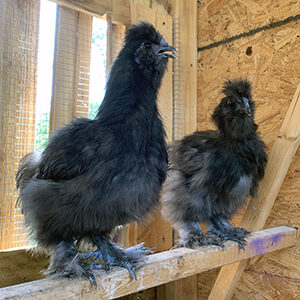
sBlack Silkie bantam hens will grow to be almost 2 pounds, and roosters can grow up to about 2 pounds and can also be found in standard chicken size. Our Black Silkies are nonbearded, so more of the face is visible. Black Silkies have five toes with feathered black legs, skin, beaks, and eyes, and roosters feature a walnut comb. Their long breeding and domestication history means most Silkies are quite docile and therefore are common backyard breeds that are kept as pets. A lack of barbicels gives their feathers a fluffy appearance but also renders them useless for flight and waterproofing so it’s important to keep them dry and protected from predators that they cannot evade. Since Silkies are not well capable for flight, they don’t need to roost heigh as they can only jump about 12 inches tall with a maximum reach of about 18 inches per jump.
Silkie often live to be nine years old and hens begin laying eggs around eight months of age, laying about 150 cream tinted PeeWee size eggs per year. The hens make fantastic mothers that often go broody, which makes them very useful as surrogates for other layers in the flock, sometimes including other birds such as ducks. Aside from being great surrogate mothers, Silkie hens can be decent egg layers as well, even though the breed is often considered ornamental. Unsurprisingly, Silkies are extremely docile, friendly birds that are sometimes subject to being bullied by larger or more aggressive birds.
APA/ABA Class: Feather Legged
American Poultry Association
American Bantam Association
Golden Duckwing Phoenix bantams are an ornamental breed of miniature chicken that was developed in Germany from standard size Phoenix chickens, originally from Japan. Phoenix varieties are renowned and coveted for their long tail feathers, which is especially noticeable for the cocks. Also known as a Gold Phoenix bantam, Golden Duckwing Phoenix bantams have gold, brown, tan, and black feathers. Aside from golden duckwing, Phoenix bantams can also come in silver duckwing, silver, golden, light brown, and white varieties.
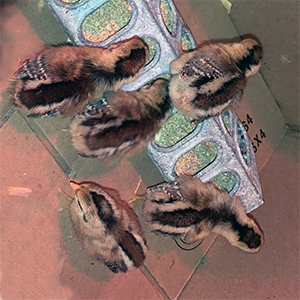
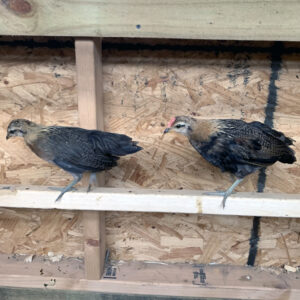
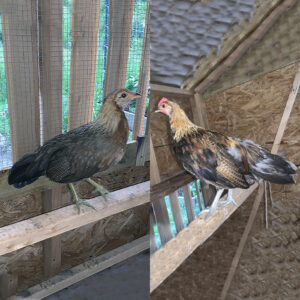
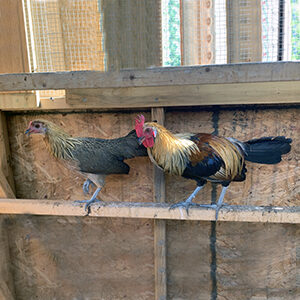
Hens grow to about 1.5 pounds, and roosters reach about 2 pounds and can also be found in standard chicken size. Phoenix bantams are active, but mostly docile, and can require special housing and ample protein to keep their long feathers intact and looking elegant. Phoenix chickens have four toes roosters with unfeathered, slate color legs, yellow skin, and rusty red or bay eyes. The beaks of phoenix chickens are generally horn in color, meaning a tan, pale gray or black color that resembles the color of animal horns. The roosters feature a single comb and tail feathers that only molt once per year so their tail feathers can grow to around three feet. Phoenix bantams are not true bantams, and like their standard size chicken counterparts, they generally prefer to roost 4 feet or higher off the ground, which also helps prevent damage to the tail feathers.
Phoenix hens begin laying around four months old and lay anywhere from 40 to 150 eggs cream tinted, bantam size PeeWee eggs each year. Phoenix bantams can live to be about eight years old and are mostly an ornamental breed that are raised for their unique tail feathers and demeanor. Phoenix hens make decent setters when they go broody, but are typically very active, even territorial at times. It’s recommended to feed a high protein diet to Phoenix bantams to ensure they have the proper nutrients to grow long, strong tail feathers and encourage egg production.
APA/ABA Class: Single Comb Clean Leg (SCCL)
American Poultry Association
American Bantam Association
Livestock Conservation Status: watch
The Livestock Conservancy
Easter Egger bantams were developed in the United States and are well known and nicknamed for the fun colored eggs the hens lay. Neither Easter Egger bantams nor standard size chickens are a recognized breed due to the wide genetic diversity used to create these birds, which includes araucana, ameraucana, and many other breeds. Along with their genetic diversity comes many feathering colors, and patterns, or lack thereof; from blonde to black and solid to broken or splashed, but they will almost always feature tufts on their cheeks.
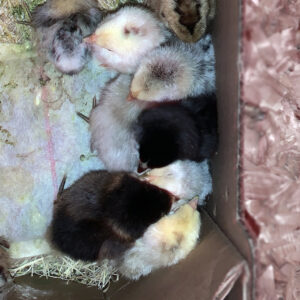
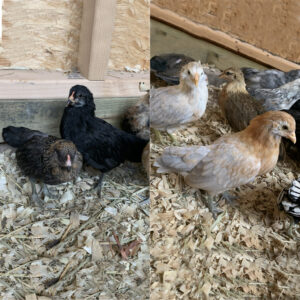
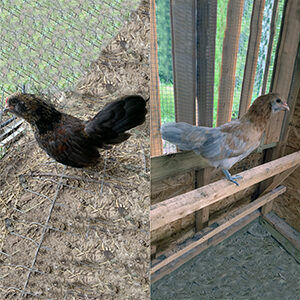
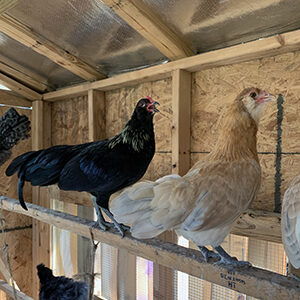
Hens will grow up to 2 pounds, and roosters can grow to be a little over 2 pounds and can also be found in standard chicken size. Easter Egger bantams have a fairly docile temperament though like with most varieties, the roosters can show aggression. Easter Egger bantams are decent flyers and prefer to roost about 2 to 4 feet above the ground. There is no standard color pattern for this variety as it’s not accepted by any poultry clubs such the American Poultry Association. This is largely due to the wide genetic diversity of Easter Egger chickens. Generally, all Easter Egger bantams have tufts, or muffs of fuzzy feathers on their cheeks due to the araucana and ameraucana breeds that bring the blue tinted egg color. Easter Eggers often have four toes with unfeathered, green, blue, or yellow tinted legs and white skin, and the roosters often feature a pea comb.
Easter Egger bantams often live up to eight years or more. Around six months of age, the hens can start laying eggs and will lay about 200 blue or green (sometimes pink or cream) tinted, PeeWee size eggs each year. Easter Egger hens make excellent broody mothers, although many breeders use surrogates or incubators to encourage their hens to keep laying. While all bantam varieties are mostly ornamental, Easter Egger bantams, sometimes called EE bantams, can be considered dual purpose birds as they can produce a usable amount of meat, although they are most commonly raised and cherished for their green tinted egg production. Mixing two Easter Eggers of any kind can create a wide range in appearance of offspring due to their extreme genetic diversity. No two Easter Egger chickens look alike!
Not a club recognized breed.
Salmon Faverolles chickens are a livestock heritage breed that originated in France in the late-1800s and was introduced to America in the early 1900s. Faverolles are good dual purpose chickens that are well capable of laying eggs through the cold winter. Salmon is a unique color pattern that is only found in Faverolles chickens.

Faverolles are a medium size chicken with hens weighing up to about 6.5 pounds and roosters weighing up to about 8 pounds and can also be found in bantam size. Faverolles chickens are a relatively calm breed that prefer to roost about 2 to 4 feet off the ground. Salmon Faverolles are recognized for their fluffy appearance, featuring a muff and beard and have five toes with feathered white legs and skin, a pink or horn color beak, and reddish bay color eyes. Their feathers are a creamy white and salmon brown color and roosters have a single comb.
Salmon Faverolles generally live about six years are slow to mature with hens taking up to ten months to start laying eggs. Once they do start laying, Favorelles hens are reliable layers, at about 190 USDA medium size light brown, sometimes slightly pink, eggs laid year round. Faverolles hens make reliable setters and mothers but often need to be encouraged to go broody. Favorelles chickens are a calm variety with roosters known to be rather quite and docile compared to other breeds. Originally a dual purpose breed, Faverolles have made their way to ornamental breed status due to their adorable, fluffy appearance, but otherwise still make good layers with eggs cherished for their pink tint.
APA Class: Feather Legged
American Poultry Association
Livestock Conservation Status: threatened
The Livestock Conservancy
Plymouth Rock chickens are a livestock heritage breed that was developed in America in the mid-1800s for use as a dual purpose chickens, which means they can be used for both egg and meat production. As one of America’s oldest breeds, Americans were encouraged to raise Plymouth Rock Chickens for meat and eggs during the World Wars to allow more food to go to soldiers. Aside from Barred, Plymouth Rocks are available in white, and rarely in blue, buff, Columbian, partridge, or silver penciled and also come in bantam sizes.
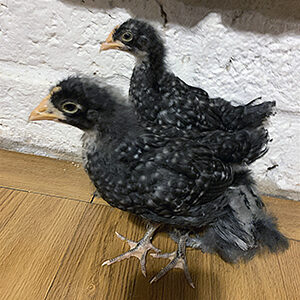
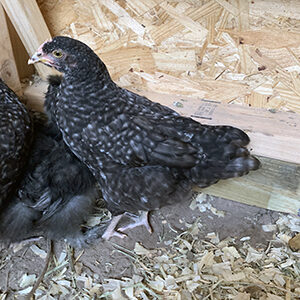
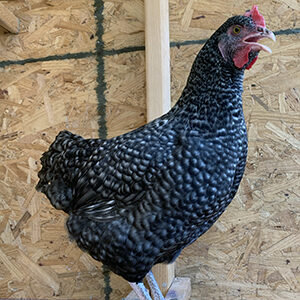
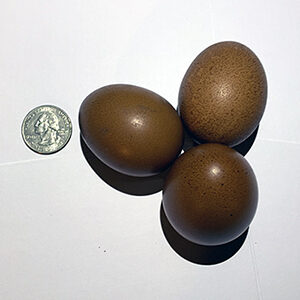
Hens will grow to be almost 7.5 pounds, and roosters can grow up to about 9.5 pounds and can also be found in bantam size. Plymouth Rock chickens are poor flyers, docile, and talkative but quiet, so they make great pets and backyard birds. Since they are not the best flyers, Plymouth Rock chickens only need to roost about 2 to 4 feet above the ground. Barred Plymouth Rock chickens have four toes with unfeathered yellow legs and skin, yellow or horn color beak, and bay color eyes, which is a rusty brown/red color. Plymouth Rock roosters feature a single comb, which is the key distinguishing trait to differentiate it from the Dominique chicken, which is also black and white and barred, but features a rose comb.
Barred Plymouth Rock hens start laying eggs when they’re around 18 weeks old, similar to many breeds that have been historically raised for egg production and/or dual purpose. They lay about 200 USDA medium to large size brown eggs year round and usually live about seven years. Plymouth Rock hens make good setters and mothers but sometimes need to be encouraged to go broody. Plymouth Rocks feather out quickly, so they can move outside quickly when brooding and reach broiler size by 8-12 weeks. Plymouth Rock chickens are considered dual purpose and because they are so great for both egg and meat production, Plymouth Rocks have served a key role in American poultry livestock development.
APA Class: American
American Poultry Association
Livestock Conservation Status: recovering
The Livestock Conservancy
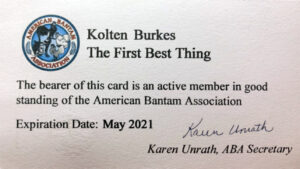
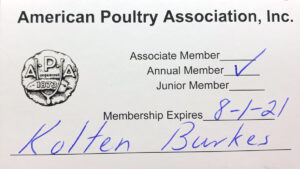
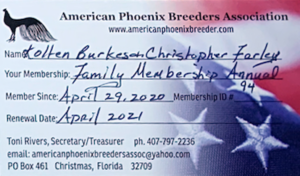
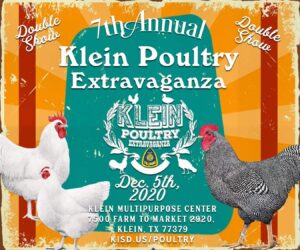
Rhode Island Red chickens are an American dual purpose breed developed in the United State of Rhode Island and appear in red and brown color tones. This breed’s incredible hardiness, high quality and reliable egg production, along with being a viable meat source, has made it historically important for livestock development with industrial and non-industrial varieties available.
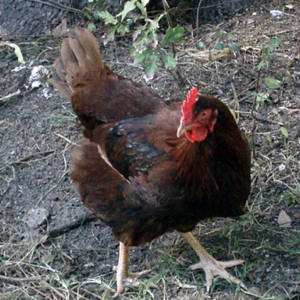
Rhode Island Red hens will grow up to about 6.5 pounds, and roosters can reach about 8.5 pounds, and can also be found in a bantam size. Rhode Isalnd Reds have four toes with unfeathered yellow legs and skin, orange and reddish bay color eyes and beak, and reddish brown feathers. The roosters can feature either a single comb or rose comb and both varieties are accepted and classed separately by the APA and ABA. Rhode Island Reds are active but docile birds that are quite clever and personable; they are also fairly capable of flight and prefer to roost about 2 to 4 feet off of the ground.
Rhode Island Red hens lay about 225 light brown or dark cream tinted, medium to large size eggs each year and can begin laying between 16 to 20 weeks and these birds can live up to about 8 years. Hens aren’t particularly broody as this trait has been bred out, but it certainly happens on occasion, in which case they make great sitters and protective mothers. Originally developed as dual purpose birds, Rhode Island Reds are now often cherished for their dark brown, reliable egg production. The success of this breed led it to be further developed for industrial use, which specialized the bird for either meat or egg production. The wide spread industrial success of the Rhode Island Red threatened the conservation status of the heritage, non-industrial breed, which has since began to cover and is now classified as a breed to watch.
APA Class: Single Comb Clean Leg (SCCL)
American Poultry Association
Livestock Conservation Status: watch
The Livestock Conservancy
Silver Laced Wyandotte chickens are a dual purpose variety that was bred in the state of New York in the 1870s and was originally referred to as the American Sebright or Sebright Cochin, even though the original breed was a large fowl variety.

Wyandottes are a medium size large fowl chicken with hens growing to about 6.5 pounds, and roosters reaching around 8.5 pounds. Wyandotte chickens are a calm breed but they are not particularly cuddly. Silver Laced Wyandottes have four toes with unfeathered, yellow legs, skin, and beak, and red, bay color eyes. The Silver Laced variety should have white feathers with black lacing that evenly outlines the edges of the white on each feather. Wyandotte roosters should feature a rose comb but feather like the hens and unlike most roosters, they do not feature the sickle shaped feathers in the tail, neck, or saddle. Wyandottes are a hardy breed and make decent flyers but should still be kept in a run for protection. These chickens prefer to roost about 2 to 4 feet above the ground.
Wyandotte hens lay about 200 light brown or cream tinted medium to large eggs each year and are not known for their broodiness, but make good mothers if they do go broody. Hens generally start laying around 18 weeks of age and Wyandottes can live up to six or more years. Wyandotte chickens are good dual purpose birds that matures at a moderate pace and offers medium frames for meat production and roughly four eggs per week.
APA Class: American
American Poultry Association
White Leghorn chickens are amongst the most common color variety of the Leghorn chicken. Originally developed in Europe, the breed was brought to the Americas in the mid to late 1800s where it was developed to have a range of colors and varieties. Although Leghorns are dual purpose birds, they are highly valued for their superior egg laying capability in addition to being hardy and offering a good feed to egg ratio.

Leghorn hens will grow up to about 4.5 pounds, and roosters can reach about 6 pounds, and can also be found in a bantam size. White Leghorns have four toes with unfeathered yellow legs, skin, and beak, red eyes, and white feathers. Leghorn roosters can feature either a single comb or rose comb and both varieties are accepted and classed separately by the APA and ABA. Leghorns prefer to roost at heights of about 2 to 4 feet above the ground as they are active birds and quite able for flight as far as chickens go.
Leghorn hens lay about 275 white color size eggs each year with eggs starting around medium size and reaching up to extra large as the hen ages. Hens can start laying eggs around 17 weeks of age and Leghorns typically live between four to six years. Mostly, Leghorns have been selectively bred over the years for high output egg production, so broodiness was bred out, but hens can still make good mothers and even foster other chicks. Heritage, non-industrial Leghorn varieties make good dual purpose birds though their frame is a bit on the smaller size for meat birds. The breed’s success has led to industrial selective breeding that can either be more specialized for meat or for large white egg production.
APA Class: Single Comb Clean Leg (SCCL)
American Poultry Association
Livestock Conservation Status: recovering
The Livestock Conservancy
Buff Leghorn chickens are a less common color variety of the Leghorn chicken. The Leghorn was introduced to the Americas in the mid-1800s and were originally known as Italians due to their origins in the Italian city of Livorno, which is where the name Leghorn is derived. By the late 1800s and into the early 1900s, the American Poultry Association had accepted 24 colors and varieties of Leghorn chickens into the Standard of Perfection.

Leghorn hens will grow up to about 4.5 pounds, and roosters can reach about 6 pounds, and can also be found in a bantam size. Buff Leghorns have four toes with unfeathered yellow legs, skin, and beak, orangish red eyes, and buff, golden blond feathers. Leghorn roosters can feature either a single comb or rose comb and both varieties are accepted and classed separately by the APA and ABA. Leghorns aren’t especially docile birds but they are quite hardy and can withstand winters well. These birds are flighty, generally able to evade predators, and prefer to roost at heights of about 2 to 4 feet above the ground.
Leghorn hens lay about 275 cream color, medium to extra large eggs each year. Buff Leghorns live about five years on average and females typically start laying eggs around 18 weeks old. Leghorns have mostly had their broodiness selectively bred out over the years to help increase output for egg production, but Leghorn hens can still make good mothers. Leghorns make good dual purpose birds though they are on the smaller size in regards to meat production. Buff leghorns are typically used for egg production and as a hardy breed, can usually lay year round.
APA Class: Single Comb Clean Leg (SCCL)
American Poultry Association
Livestock Conservation Status: recovering
The Livestock Conservancy
Like their bantam counterparts, standard size Easter Egger chickens were developed in the United States and are well known and nicknamed for the fun colored eggs the hens lay. Neither Easter Egger chickens or bantams are a recognized breed due to the wide genetic diversity used to create these birds, which includes araucana, ameraucana, and many other breeds. Along with their genetic diversity comes a multitude of feathering colors and patterns, or lack thereof; from buff to blue and solid to laced or barred, but they will almost always feature tufts on their cheeks.
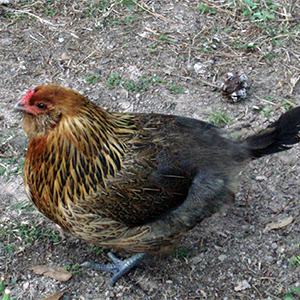
Easter Egger hens will grow up to about 6 pounds, and roosters can grow to be around 7 pounds and can also be found in bantam size. Easter Egger chickens typically have docile temperaments, but their demeanor, much like their color, can depend widely on their genetic makeup. Easter Eggers are decent flyers and usually roost 2 to 4 feet above the ground. Like their bantam counterpart, there is no standard description for Easter Egger chickens since this variety is not accepted by any poultry clubs, largely due to the wide genetic diversity of Easter Eggers. Generally, Easter Egger chickens have tufts of fuzzy feathers on their cheeks due, a trait from the araucana and ameraucana breeds that also bring in the blue tinted eggs that the variety is famous for. Easter Eggers usually have four toes with unfeathered, green, blue, or yellow tinted legs and white skin, and the roosters often feature a pea comb.
Easter Egger hens lay about 250 blue or green (sometimes pink or cream) tinted large to extra large eggs each year and make excellent broody mothers although it may need to be encouraged. Many Easter Eggers mature slowly and take about seven months to begin laying eggs, but commonly live up to eight or more years. Mixing two Easter Eggers can create a wide range in appearance of Easter Egger offspring due to their genetic diversity that can include any combination of other chicken genetics. Generally considered dual purpose birds, their productivity for either meat or eggs again will largely depend on their unique genetic makeup with some offering larger or more eggs per year while other carry a larger frame although the hens should always lay a blue/green tint egg.
Not a recognized breed.
Visit their website to learn more about what they do and how you can help.
As a nonprofit, any money their shop earns is used to cover the costs of medical and daily care for rehabilitating these animals.
Whether or not you can or feel compelled to donate, please consider spreading our fundraising campaign.
Click on one of the Social Icons below to easily share our campaign to rehabilitate our canine friends.